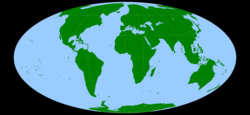
Back Kwartêr Afrikaans Quartär (Geologie) ALS العصر الرباعي Arabic Cuaternariu AST Dördüncü dövr Azerbaijani Дүртенсел осор Bashkir Чацвярцічны перыяд Byelorussian Кватернер Bulgarian কোয়াটারনারি Bengali/Bangla Kvartar BS
| Quaternary | |||||||||
|---|---|---|---|---|---|---|---|---|---|
 A map of the world as it appeared during the Pleistocene epoch, c. 1 Ma | |||||||||
| Chronology | |||||||||
| |||||||||
| Etymology | |||||||||
| Name formality | Formal | ||||||||
| Usage information | |||||||||
| Celestial body | Earth | ||||||||
| Regional usage | Global (ICS) | ||||||||
| Time scale(s) used | ICS Time Scale | ||||||||
| Definition | |||||||||
| Chronological unit | Period | ||||||||
| Stratigraphic unit | System | ||||||||
| Time span formality | Formal | ||||||||
| Lower boundary definition |
| ||||||||
| Lower boundary GSSP | Monte San Nicola Section, Gela, Sicily, Italy 37°08′49″N 14°12′13″E / 37.1469°N 14.2035°E | ||||||||
| Lower GSSP ratified | 2009 (as base of Quaternary and Pleistocene)[3] | ||||||||
| Upper boundary definition | Present day | ||||||||
| Upper boundary GSSP | N/A | ||||||||
| Upper GSSP ratified | N/A | ||||||||
| Atmospheric and climatic data | |||||||||
| Mean atmospheric O2 content | c. 20.8 vol % (104 % of modern) | ||||||||
| Mean atmospheric CO2 content | c. 250 ppm (1 times pre-industrial) | ||||||||
| Mean surface temperature | c. 14 °C (0 °C above modern) | ||||||||
The Quaternary (/kwəˈtɜːrnəri, ˈkwɒtərnɛri/ kwə-TUR-nə-ree, KWOT-ər-nerr-ee) is the current and most recent of the three periods of the Cenozoic Era in the geologic time scale of the International Commission on Stratigraphy (ICS).[4] It follows the Neogene Period and spans from 2.58 million years ago to the present.[5] As of 2023, the Quaternary Period is divided into two epochs: the Pleistocene (2.58 million years ago to 11.7 thousand years ago) and the Holocene (11.7 thousand years ago to today); a third epoch, the Anthropocene, has recently been proposed, but it is not officially recognised by the ICS.
The Quaternary Period is typically defined by the cyclic growth and decay of continental ice sheets related to the Milankovitch cycles and the associated climate and environmental changes that they caused.[6][7]
- ^ Cohen, K. M.; Finney, S. C.; Gibbard, P. L.; Fan, J.-X. (January 2020). "International Chronostratigraphic Chart" (PDF). International Commission on Stratigraphy. Retrieved 23 February 2020.
- ^ Mike Walker; et al. (December 2018). "Formal ratification of the subdivision of the Holocene Series/Epoch (Quaternary System/Period)" (PDF). Episodes. 41 (4). Subcommission on Quaternary Stratigraphy (SQS): 213–223. doi:10.18814/epiiugs/2018/018016. Retrieved 11 November 2019.
- ^ Gibbard, Philip; Head, Martin (September 2010). "The newly-ratified definition of the Quaternary System/Period and redefinition of the Pleistocene Series/Epoch, and comparison of proposals advanced prior to formal ratification" (PDF). Episodes. 33 (3): 152–158. doi:10.18814/epiiugs/2010/v33i3/002. Retrieved 8 December 2020.
- ^ Cohen, K.M.; Finney, S.C.; Gibbard, P.L.; Fan, J.-X. "International Chronostratigraphic Chart 2013" (PDF). stratigraphy.org. ICS. Retrieved 15 June 2014.
- ^ "Stratigraphic Chart 2022" (PDF). International Stratigraphic Commission. February 2022. Retrieved 4 June 2022.
- ^ Denton, G.H.; Anderson, R.F.; Toggweiler, J.R.; Edwards, R.L.; Schaefer, J.M.; Putnam, A.E. (2010). "The Last Glacial Termination". Science. 328 (5986): 1652–1656. Bibcode:2010Sci...328.1652D. CiteSeerX 10.1.1.1018.5454. doi:10.1126/science.1184119. PMID 20576882. S2CID 27485445.
- ^ Lowe, J.J.; Walker, M.J.C. (1997). Reconstructing Quaternary Environments. Routledge. ISBN 978-0582101661.
© MMXXIII Rich X Search. We shall prevail. All rights reserved. Rich X Search